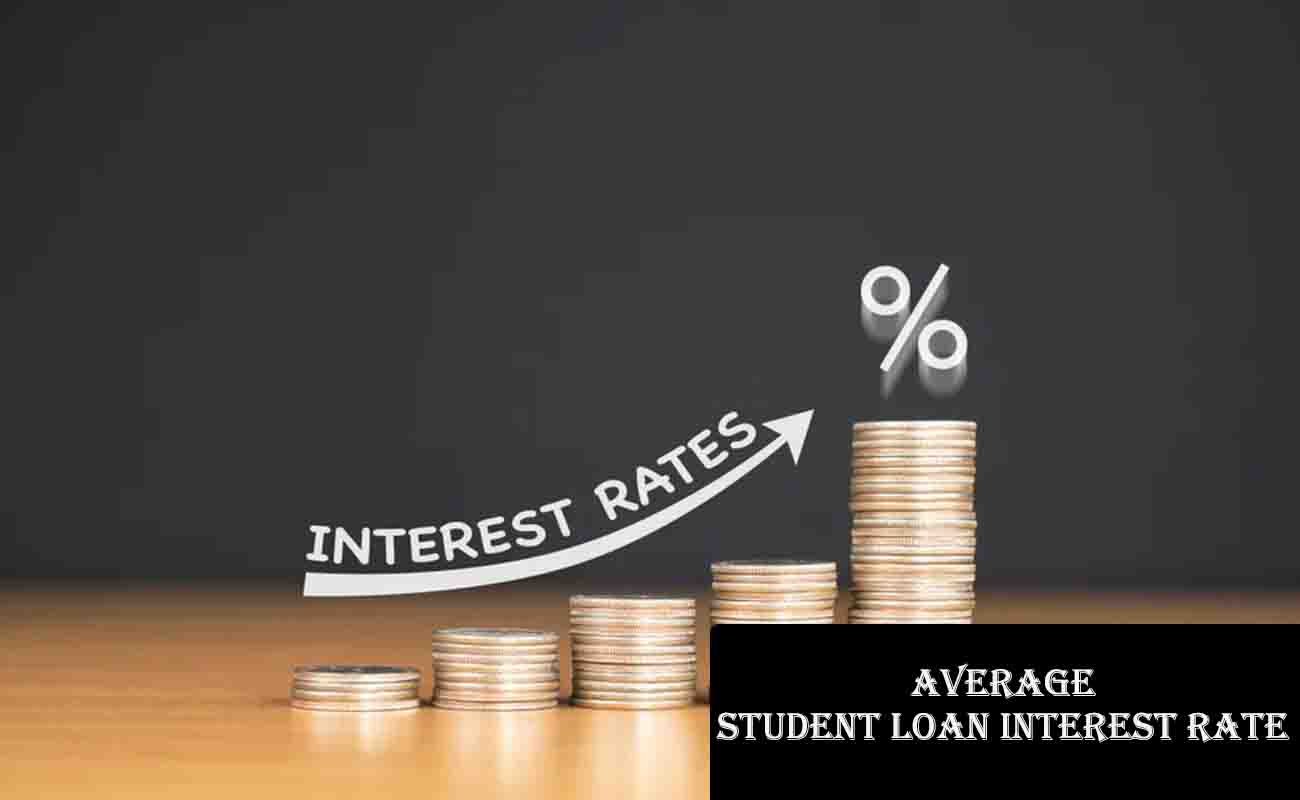The average student loan interest rate for 2025-2026 varies: federal undergraduate loans are at 6.39%, graduate loans at 7.94%, and loans at 8.94%. Private loan rates range from 3.24% to 26%, depending on creditworthiness.

Interest rates significantly impact the total cost of your loan, with higher rates increasing the amount you repay over time. Federal loans offer fixed rates and borrower protections, while private loans may have variable rates and fewer repayment options.
Rates are influenced by economic factors like the 10-year Treasury note for federal loans and credit scores for private loans. You can manage interest costs through strategies like extra payments, refinancing, or choosing federal loans for their benefits.
I’m here to guide you through the world of the average student loan interest rate, a crucial piece of the puzzle when borrowing for college or graduate school. Whether you’re just starting to explore loans or already navigating repayment, I’ll break it down in simple terms so you can make informed decisions.
Let’s dive into what these rates are, how they work, and how you can manage them to keep your finances on track. In this guide, we’ll cover the current average student loan interest rates for 2025, the differences between federal and private loans, how rates are set, their impact on your loan’s cost, historical trends, and practical tips for managing them.
I’ll also answer common questions and provide reliable sources to back it up. By the end, you’ll feel confident navigating this aspect of your financial journey.
What Are Student Loan Interest Rates?
The average student loan interest rate is the percentage charged on the borrowed amount, essentially the cost of using someone else’s money to pay for your education. For 2025-2026, federal loans have fixed rates: 6.39% for undergraduates, 7.94% for graduates, and 8.94% for PLUS loans. Private loans, however, can range from 3.24% to 26%, depending on your credit score. These rates determine how much extra you’ll pay beyond the loan principal.
Why Should You Care About Student Loan Interest Rates?
Interest rates matter because they directly affect your loan’s total cost. A lower rate means less interest over time, saving you money. For example, a $10,000 loan at 6.39% over 10 years costs about $3,800 in interest, while at 8.94%, it’s around $5,300. Understanding these rates helps you budget, compare loan options, and plan repayment strategies.
What is the Average Student Loan Interest Rate?
The average student loan interest rate represents the cost of borrowing money for education, expressed as a percentage of the loan amount. For the 2025-2026 academic year, federal student loan rates are fixed and set as follows:
| Loan Type | Borrower | Fixed Interest Rate |
|---|---|---|
| Direct Subsidized & Unsubsidized Loans | Undergraduate students | 6.39% |
| Direct Unsubsidized Loans | Graduate or professional students | 7.94% |
| Direct PLUS Loans | Parents and graduate/professional students | 8.94% |
Private student loan rates, on the other hand, vary widely based on your creditworthiness. As of July 2025, they range from 3.24% to 26% for new loans and 4% to just under 14% for refinancing, according to sources like Bankrate. These rates can be fixed or variable, meaning they might change with market conditions.
Why does this matter? The interest rate determines how much extra you’ll pay over the life of your loan. For example, borrowing $10,000 at 6.39% over 10 years means about $3,800 in interest, while at 8.94%, it’s closer to $5,300. That’s a big difference for your wallet!
Why Understanding Interest Rates Matters
Knowing your loan’s interest rate helps you plan your finances and avoid surprises. A higher rate increases your monthly payments and the total cost of your education, while a lower rate can save you thousands. For instance, on a $30,000 loan over 10 years, a 6.39% rate results in about $11,400 in interest, but at 8.94%, it’s $15,900—a $4,500 difference. Understanding these numbers empowers you to compare loan options, choose the right repayment plan, and decide if strategies like refinancing make sense for you.
Federal vs. Private Student Loans
When borrowing for school, you’ll typically choose between federal and private loans, each with distinct interest rate structures and benefits.
Federal Loans: These are funded by the U.S. government and have fixed interest rates, meaning they stay the same throughout the loan term. For 2025-2026, rates are 6.39% for undergraduates, 7.94% for graduates, and 8.94% for PLUS loans. Federal loans also come with perks like income-driven repayment plans, loan forgiveness programs, and deferment options, making them a safer choice for many borrowers. However, they include origination fees (1.057% for subsidized/unsubsidized loans, 4.228% for PLUS loans), which slightly increase the cost.
Private Loans: Offered by banks, credit unions, or online lenders, private loans can have fixed or variable rates. As of July 2025, rates range from 3.24% to 26%, depending on your credit score, income, and whether you have a cosigner. While borrowers with excellent credit might snag lower rates than federal loans, private loans often lack flexible repayment options and protections. Variable rates can also rise over time, adding uncertainty.
Choosing between federal and private loans depends on your financial situation. If you qualify for low private loan rates, they might save you money, but federal loans are often the better choice for their stability and benefits.
How Interest Rates Are Determined
Federal student loan rates are set annually by Congress, based on the high yield of the 10-year Treasury note from the May auction, plus a fixed percentage:
- Undergraduate loans: Treasury yield + 2.05%, capped at 8.25%.
- Graduate loans: Treasury yield + 3.60%, capped at 9.50%.
- PLUS loans: Treasury yield + 4.60%, capped at 10.50%.
For example, if the Treasury yield is 4.34%, the undergraduate rate would be 6.39% (4.34% + 2.05%). These caps protect borrowers from extreme rate hikes during economic shifts.
Private loan rates are set by lenders and depend on factors like:
- Credit Score: A score above 689 often qualifies for lower rates.
- Income and Debt-to-Income Ratio: Higher income and lower debt improve your chances of a better rate.
- Cosigner: A creditworthy cosigner can secure a lower rate if your credit is weak.
- Market Conditions: Rates are influenced by benchmarks like the Secured Overnight Financing Rate (SOFR).
Understanding these factors can help you improve your credit or find a cosigner to get a better rate. Check Federal Student Aid for more on federal loan rates.
Impact on Total Loan Cost
The interest rate directly affects how much you’ll repay. Most student loans use simple interest, calculated daily as:
[ \text{Interest Amount} = (\text{Outstanding Principal} \times \text{Interest Rate} / 365) \times \text{Days Since Last Payment} ]
For a $10,000 loan at 6.39%, the daily interest rate is 0.0175% (6.39% ÷ 365), or about $1.75 per day. Over a year, that’s roughly $640 in interest. Over 10 years, the total interest is about $3,800, making the total repayment $13,800. At 8.94%, the daily rate is 0.0245%, or $2.45 per day, leading to $5,300 in interest over 10 years, for a total of $15,300.
Federal loans also have origination fees, which reduce the amount you receive but are included in what you repay. For example, a $10,000 loan with a 1.057% fee means you get $9,894 but repay $10,000 plus interest. For PLUS loans, the 4.228% fee means a $10,000 loan disburses $9,577 but requires repaying the full $10,000 plus interest.
Historical Trends in Student Loan Interest Rates
Federal student loan rates have varied over time, reflecting economic conditions. Here’s a look at undergraduate rates over recent years, based on Finaid:
| Year | Direct Subsidized/Unsubsidized Rate |
|---|---|
| 2025-2026 | 6.39% |
| 2024-2025 | 6.53% |
| 2023-2024 | 5.50% |
| 2022-2023 | 4.99% |
| 2021-2022 | 3.73% |
| 2020-2021 | 2.75% |
Rates hit a low of 2.75% in 2020-2021 due to the pandemic but have risen steadily since. Private loan rates have also fluctuated, with averages around 9.66% for fixed rates and 7.81% for variable rates in 2017, per Education Data. Keeping an eye on these trends can help you anticipate future rates when planning loans.
Tips for Managing Your Student Loan Interest Rates
Here are practical ways to keep your interest costs down:
- Prioritize Federal Loans: Their fixed rates and protections like income-driven repayment make them a safer bet.
- Pay Interest During School: For unsubsidized or private loans, paying interest while in school prevents it from capitalizing, reducing your total debt.
- Make Extra Payments: Paying more than the minimum reduces the principal faster, cutting interest costs.
- Refinance Strategically: If you have strong credit, refinancing to a lower rate can save money, but federal loans lose benefits like forgiveness when refinanced.
- Seek Discounts: Many lenders offer a 0.25% rate reduction for autopay. Check with lenders like Sallie Mae for details.
- Borrow Only What You Need: Minimize borrowing by using scholarships, grants, or part-time work to cover costs.
- Use Loan Calculators: Tools on sites like Bankrate can show how rates and payments affect your loan’s cost.
Frequently Asked Questions (FAQs)
Q: What’s the difference between fixed and variable interest rates?
A: Fixed rates remain constant, offering predictable payments. Variable rates can change with market conditions, potentially lowering or raising your payments. Federal loans are always fixed, while private loans can be either.
Q: Can I lower my student loan interest rate?
A: Yes, refinancing with a private lender can lower your rate if your credit is strong, but you’ll lose federal benefits. Autopay discounts or improving your credit score can also help.
Q: How do I find the best student loan rates?
A: Compare offers from multiple private lenders, checking rates on sites like Credible. For federal loans, rates are standard, so focus on loan type and benefits.
Q: What if I can’t pay my student loans?
A: Contact your loan servicer to explore options like deferment, forbearance, or income-driven repayment for federal loans. Private lenders may offer fewer options, so act quickly.
Reference
- Bankrate – Student loan interest rates in July 2025
- Education Data Initiative – Average Student Loan Interest Rate (2025): Federal vs Private
- Business Insider – Student Loan Interest Rates 2025: Compare Federal and Private Options
- NerdWallet – Student Loan Interest Rates: Federal, Private, Refinancing
- Finaid – Historical Federal Student Loan Rates
- Federal Student Aid – Interest Rates and Fees for Federal Student Loans
- Earnest – Student loan interest rate predictions for 2025
- Investopedia – Student Loan Interest Rates
- Newsweek – Student Loan Interest Rates
